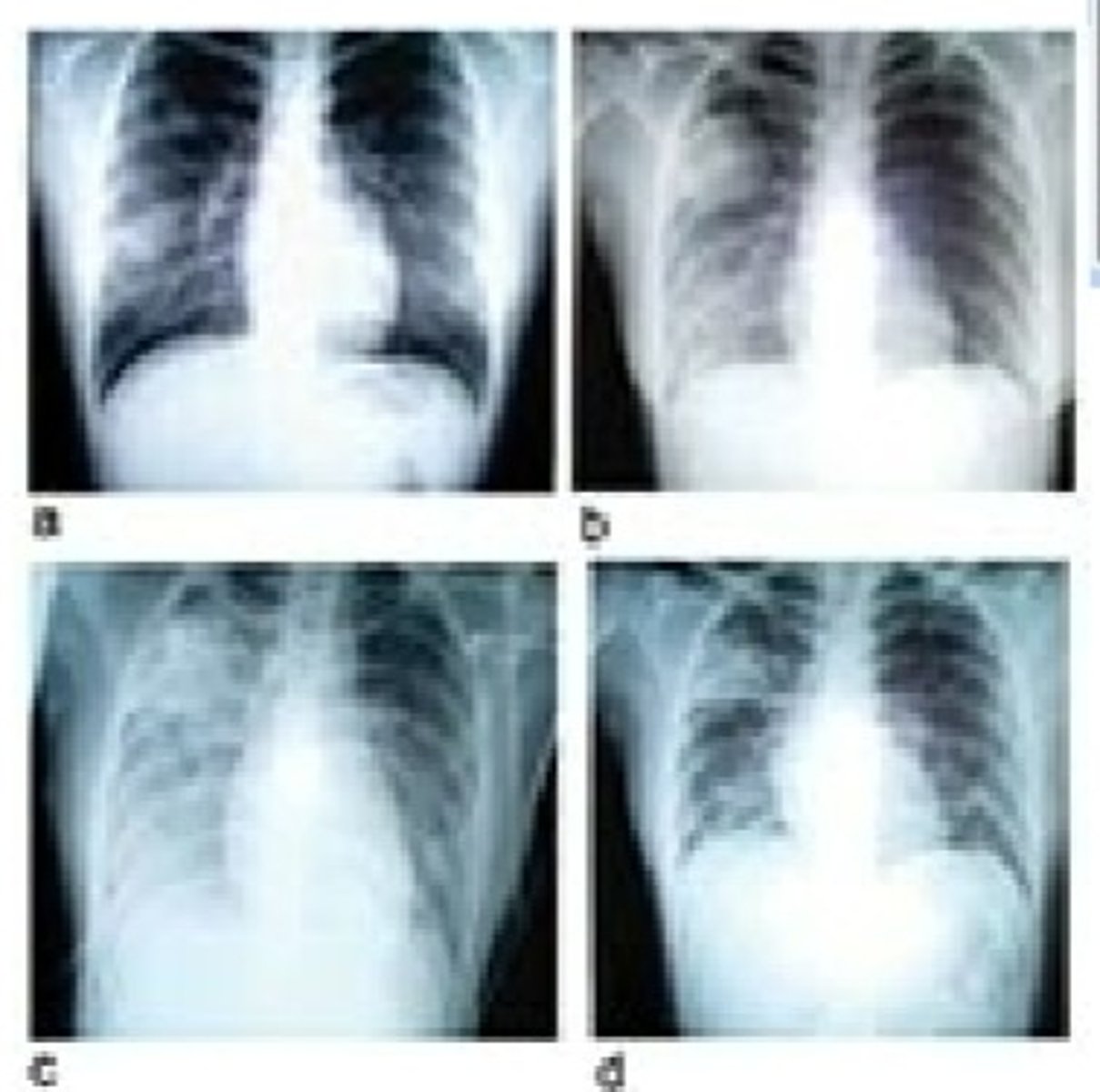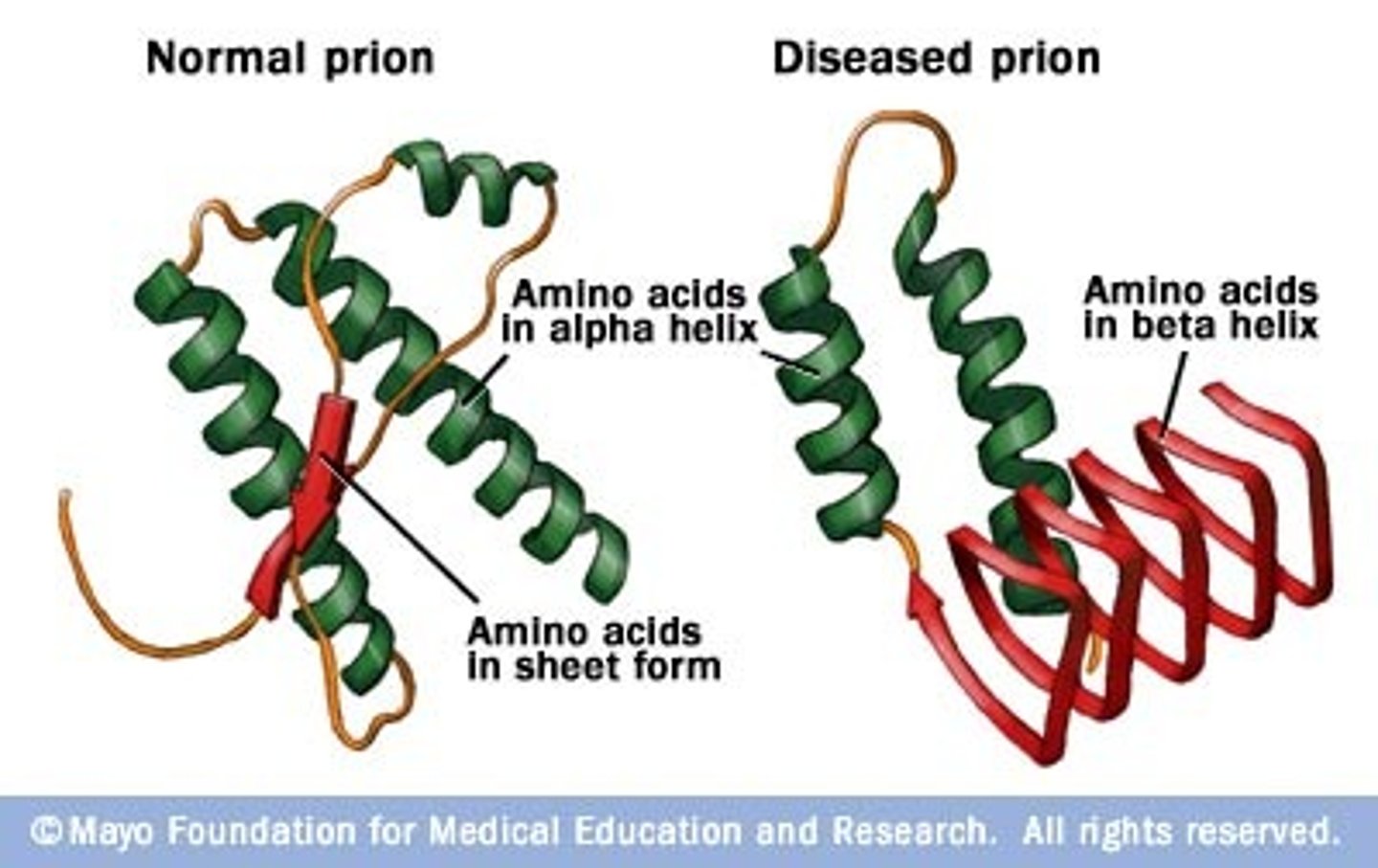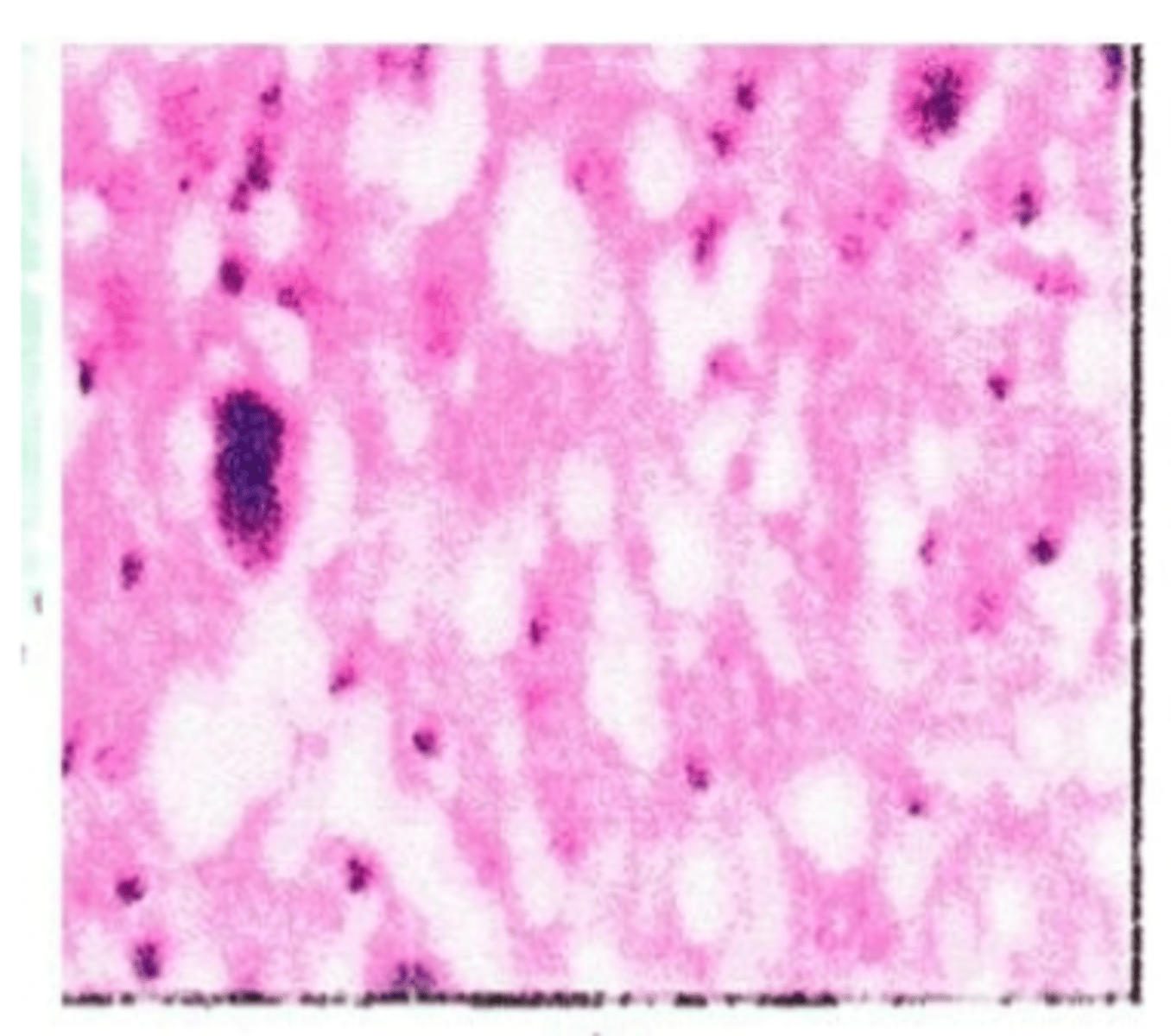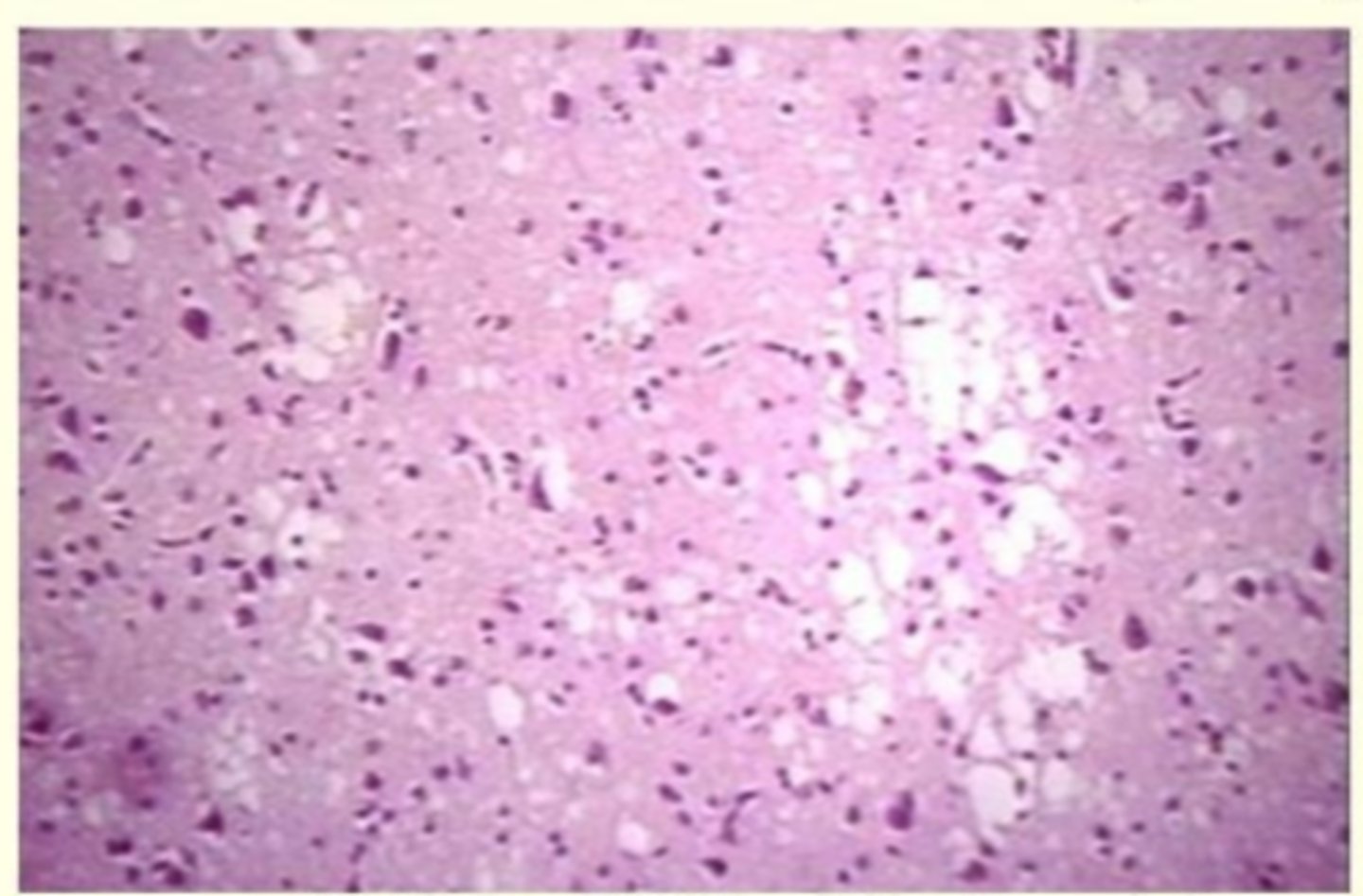Prions and Viroids
1/30
There's no tags or description
Looks like no tags are added yet.
Name | Mastery | Learn | Test | Matching | Spaced |
|---|
No study sessions yet.
31 Terms
Ebola, HIV, and SARS (Severe Acute Respiratory Syndrome)
3 major viruses are:
Ebola (killer virus)
It is an RNA virus that spreads by close contact and kills between 25 and 90 percent of victims
There is no cure or vaccine
The Ebola virus is a zoonotic disease. Zoonotic diseases involve animals and humans
Bats are the reservoir host for the ebola virus
symptoms of early stage ebola
headache, fever, fatigue, muscle pain, and sore throat
symptoms of advanced stage ebola
Impaired liver and kidneys, diarrhea, vomiting, rash, internal and external bleeding, and bleeding from eyes, nose, and mouth
preventative measures for Ebola
Stop contact with infected animals and the consumption of their meat
Isolate the sick
Prompt disposal of victims’ bodies
Disinfect homes of dead and infected
Protective clothing for healthcare workers
There was a facility in Reston, Virginia, that had monkeys that were dying. CDC and other organizations took plane flights to examine the monkeys. They discovered that an Ebola-type virus was killing the monkeys. By this time, thousands of people had been exposed. But this was an Ebola that was only fatal to monkeys, it was not fatal to humans. If it had been Ebola that killed humans, we would have had a major outbreak in the United States
The Hot Zone is a nonfiction book dealing with Ebola in the United States.
is very dangerous because it affects the immune system. It is also an RNA virus, and it has an envelope
The Human Immunodeficiency Virus (HIV) that causes AIDS:
activate B cells that produce antibodies ad activate Killer T cells that destroy infected cells
HIV infects Helper T cells. Normally Helper T cells have two functions:
People with AIDS die of secondary infections, like pneumonia, because their immune system could not fight the infection
Without Helper T cells functioning properly, you cannot effectively fight off pathogens that can make you sick.
Severe Acute Respiratory Syndrome or SARS
Caused by SARS coronavirus
Outbreak in China in 2002-2003
No cases since 2004
Severe Acute Respiratory Syndrome symptoms
Flu-like including fever, lethargy, myalgia, and cough.
Fever above 100.4°F was the only symptom that all patients had in common
Chest X-rays for SARS show atypical pneumonia, normally with patchy infiltrates
Chest radiographs of index patient with severe acute respiratory syndrome (SARS). a, day 5 of symptoms; b, day 10; c, day 13; d, day 15.

COVID 19
A contagious respiratory disease that was first detected in China in December 2019 has spread worldwide. The 2019 novel (new) coronavirus has been named SARS-CoV-2, and the disease it causes is called coronavirus disease 2019, or COVID-19
We learned about this particular virus shortly after a cluster of severe pneumonia cases were reported on New Year's Eve 2019 in Wuhan, which is in the Hubei Province of China
This virus is really transmissible and can spread easily from person to person even before a person develops symptoms. It's carried on respiratory droplets when we talk, sneeze, and cough, and these can land on surfaces or in someone's mouth or nose. When it comes to respiratory droplets, 6 feet is the magic distance. That's how far these tiny, infected droplets can travel. Being within 6 feet of someone who is sick can get you or your personal space contaminated with COVID-19
When droplets land on surfaces, we can pick them up with our hands and transfer them to our eyes, mouth, and nose when we touch our faces. This is why hand hygiene is so important. Good hand hygiene means washing our hands not just after we're using the restroom or before we're eating, but regularly throughout the day. Respiratory secretions (like snot and sputum) are also infectious, so cover your coughs and sneezes, use disposable tissues, throw them away when you're done, and wash your hands afterward. Keep your work surfaces clean and wipe off your keyboard and your phone
prions
are infectious proteins that have no genetic material

viroids
are infectious agents with genetic material that do not have protein
neither prions or viroids are viruses
prion
a type of protein that can trigger normal proteins in the brain to fold abnormally. Prion diseases can affect both humans and animals and are sometimes spread to humans by infected meat products
prion diseases
the infected protein comes in contact with a healthy protein and transforms it into an abnormally folding protein
prion disease comparison is like a zombie in the walking dead bites someone and they turn into a zombie
Elk brain tissue
the light spots show spongy areas where tissue has been destroyed
Elk brain tissue with chronic wasting disease. The gaps in the brain tissue are because of the abnormal folding with the prion tissues

Types of prions found in animals
Bovine Spongiform Encephalopathy (BSE) - is the main one, known as mad cow disease
Chronic Wasting Disease (CWD) - affects deer
Scrapie - affects sheep
Transmissible Mink Encephalopathy - affects mink
Feline Spongiform Encephalopathy - affects cats
Ungulate Spongiform Encephalopathy - affects the group of animals, the ungulates
Bovine Spongiform Encephalopathy or BSE
A chronic, degenerative disease that affects the central nervous system (CNS) of cattle
Commonly referred to as "mad cow disease"
mad cow disease
Mad cow disease, or bovine spongiform encephalopathy, is a neurological disorder in cattle. It is caused by an abnormal protein called a prion that infects a cow's central nervous system and causes brain and nerve cells to die. Prions are passed to humans through consumption, and that can trigger the human form of the disease.
How it spreads from cows to humans
1. A person eats contaminated food. Prions are found primarily in brain or spinal cord tissue from an infected animal.
2. After a person ingests infected meat, prions spread to the brain through the body's lymph nodes and immune system, where they can remain dormant for years.
3. Disease attacks the nervous system. Outer layer of brain develops tiny holes, looks spongy. The host goes into seizures; death may occur.
Prevention of mad cow disease
Eradication: Infected farm animals are destroyed.
Regulations: Animal products containing brain or central nervous system tissue aren’t used as livestock feed.
Consumers: Avoid beef that contains parts of the cow’s main nervous system. Prions are heat-resistant, so cooking the meat will not reduce the risk.
If 1 cow had BSE out of 100 cows, and the 100 cows ate the ground-up cow with BSE, then those 100 other cows have now been exposed to BSE
After cows were slaughtered, the meat industry ground up their bones, organs, and nervous tissue to put in cow feed to feed cattle to save money.
chronic wasting disease
Prion disease attacks deer and elk in the brain and brain stem
Diseased tissue resembles a sponge; affected cells develop large holes called vacuoles
Types of prions in humans
Creutzfeldt-Jakob Disease (CJD)
Variant Creutzfeldt-Jakob Disease (vCJD) - mad cow disease has an impact on human health and can create that variant to people who have eaten cow
Kuru
Creutzfeldt-Jakob Disease (CJD)
is caused by abnormal proteins called prions that are not killed by standard methods for sterilizing surgical equipment
As prions build up in cells, the brain slowly shrinks and the tissue fills with holes until it resembles a sponge
Consequences - Those affected lose the ability to think and to move properly and suffer from memory loss. It is always fatal, usually within one year of the onset of illness
Creutzfeldt-Jakob Disease under a microscope
cerebral cortex with coarse and fine vacuolations (spongiosis)

Kuru
Identified by epidemiology in New Guinea based on anthropological research by Robert and Louise Glasse in the 1950s
1% of the Fore tribe was afflicted, mostly women, some children, few adult males
Symptoms: headache, joint pain, then 6-12 weeks later, difficulty walking, then death, usually within 12 months, always within 2 years
Disease was of recent origin: 1910-1920
Epidemiological evidence led the Glasses to suggest that endocannibalism was associated with disease
This hypothesis was not well accepted among the medical community
endocannibalism
eating a dead loved one
Viroids
Unlike viruses, only made up of genetic material (SS RNA)
No protein coat
Only a little larger than prions
Mainly in plants
Spread through contact between plants. Example is potato spindle viroid